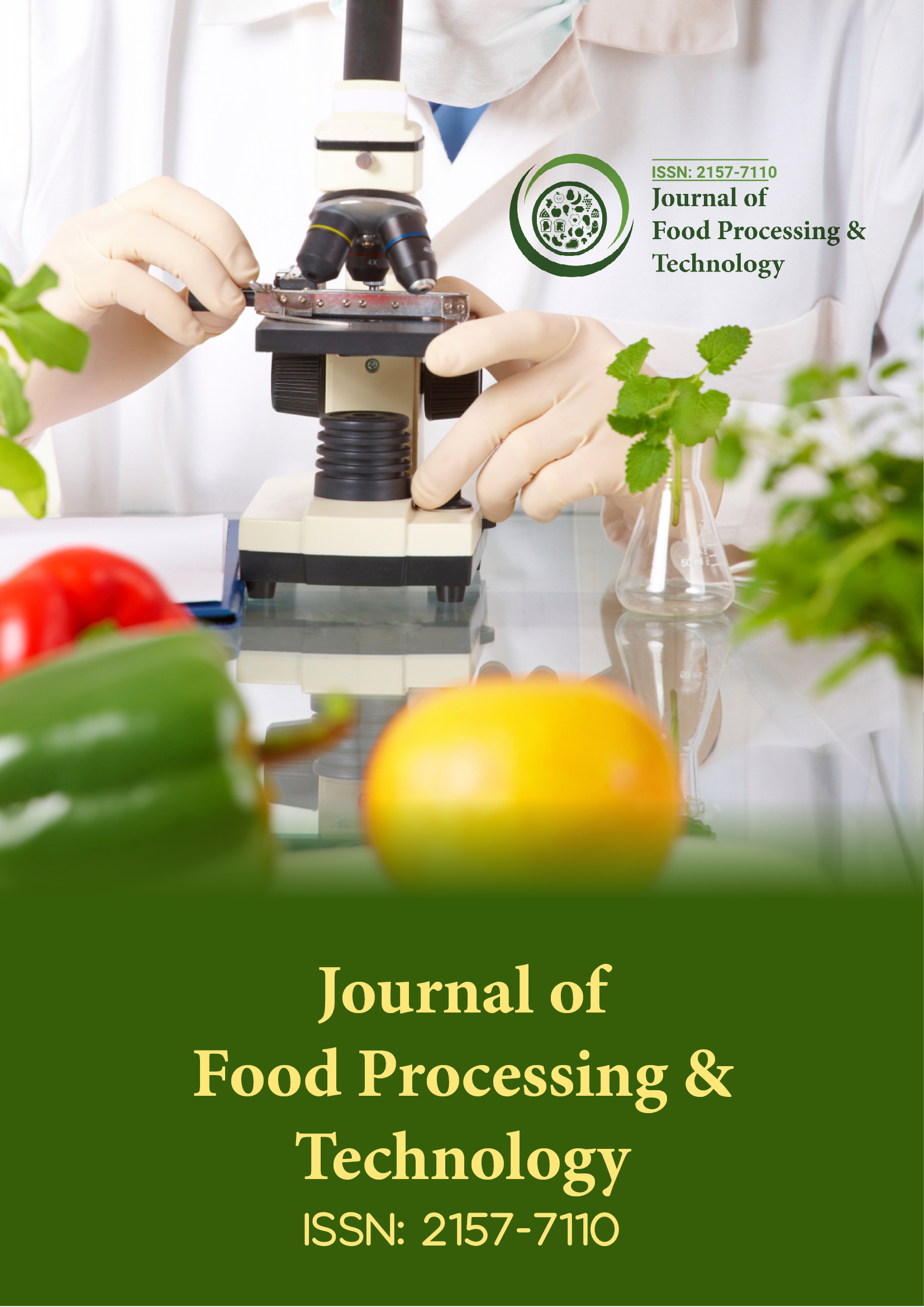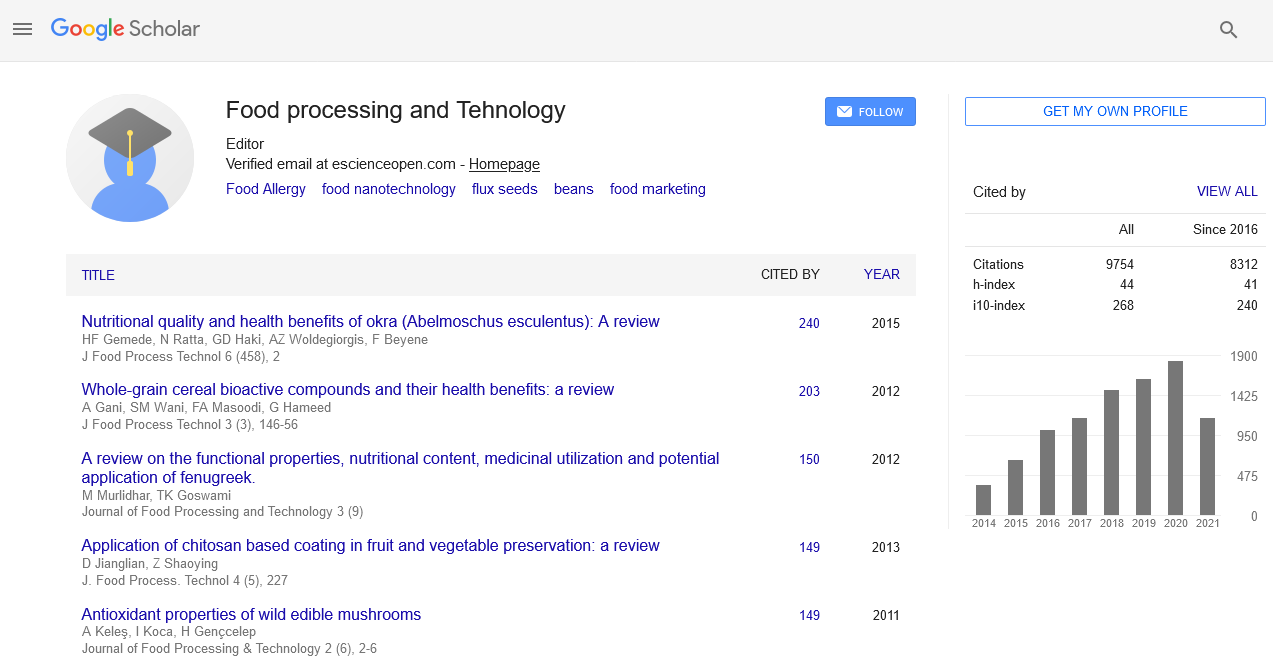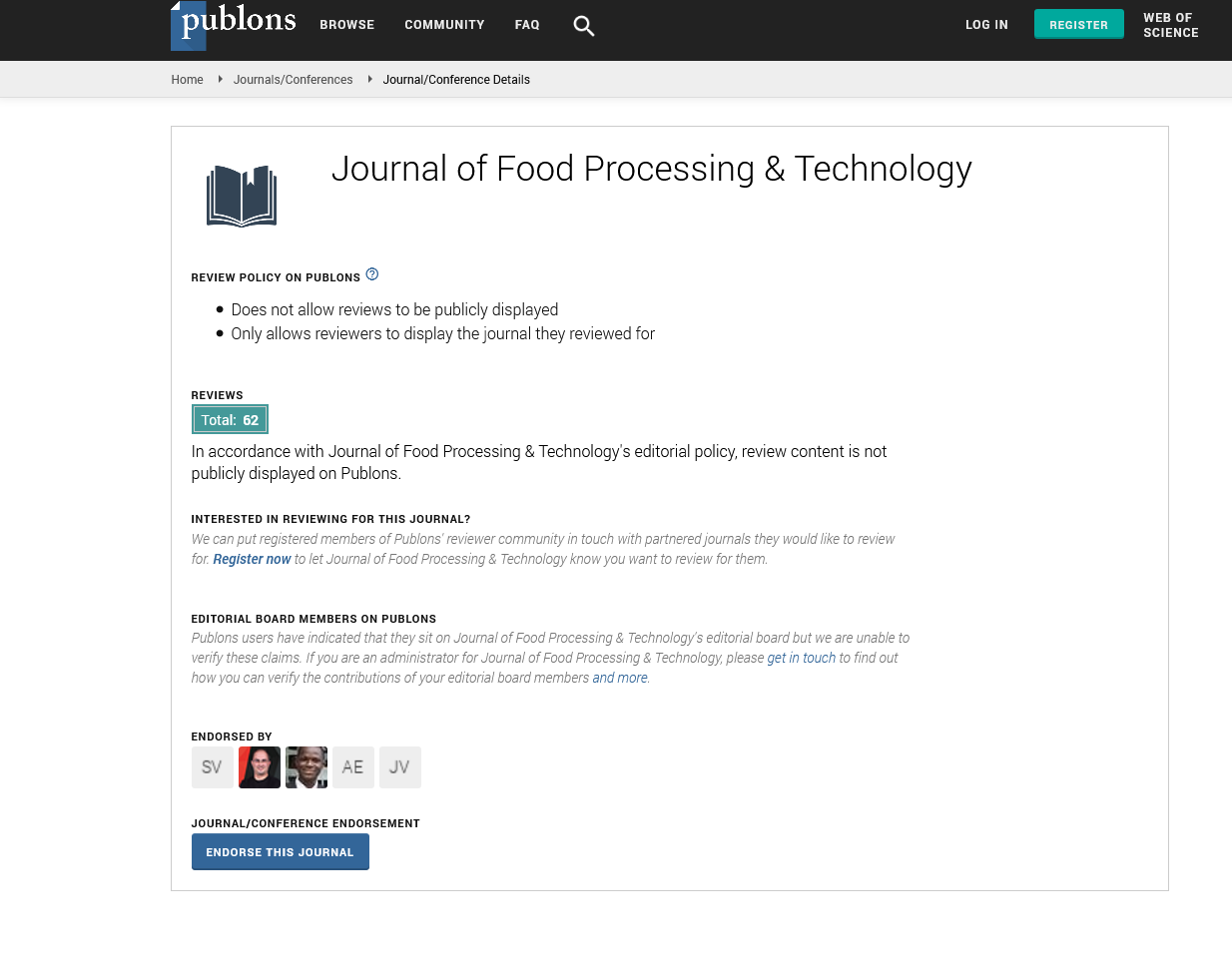Indexed In
- Genamics JournalSeek
- Academic Keys
- JournalTOCs
- China National Knowledge Infrastructure (CNKI)
- Access to Global Online Research in Agriculture (AGORA)
- Centre for Agriculture and Biosciences International (CABI)
- RefSeek
- Directory of Research Journal Indexing (DRJI)
- Hamdard University
- EBSCO A-Z
- OCLC- WorldCat
- Scholarsteer
- SWB online catalog
- Publons
- Euro Pub
- Google Scholar
Useful Links
Share This Page
Journal Flyer

Open Access Journals
- Agri and Aquaculture
- Biochemistry
- Bioinformatics & Systems Biology
- Business & Management
- Chemistry
- Clinical Sciences
- Engineering
- Food & Nutrition
- General Science
- Genetics & Molecular Biology
- Immunology & Microbiology
- Medical Sciences
- Neuroscience & Psychology
- Nursing & Health Care
- Pharmaceutical Sciences
Perspective - (2025) Volume 16, Issue 1
High-Pressure Processing and Its Effect on Meat Shelf Life
Emily Watson*Received: 27-Jan-2025, Manuscript No. JFPT-25-29164; Editor assigned: 29-Jan-2025, Pre QC No. JFPT-25-29164; Reviewed: 12-Feb-2025, QC No. JFPT-25-29164; Revised: 18-Feb-2025, Manuscript No. JFPT-25-29164; Published: 26-Feb-2025, DOI: 10.35248/2157-7110.25.16.1140
Description
High-Pressure Processing (HPP) is a non-thermal food preservation method that has gained significant attention in the meat industry for its ability to enhance food safety and extend shelf life without compromising nutritional and sensory qualities. This innovative technology involves subjecting prepackaged meat products to very high levels of hydrostatic pressure, typically ranging from 300 to 600 Mega Pascals (MPa), for a few seconds to several minutes. Unlike traditional thermal processing methods that rely on heat to inactivate microorganisms, HPP achieves microbial decontamination through the application of uniform pressure, which disrupts cellular functions in pathogenic and spoilage organisms while retaining the freshness, color, and flavor of the product.
The extension of shelf life in meat products is one of the most important outcomes of high pressure processing. Meat is highly perishable due to its high water activity, protein content, and favorable pH, which provide an ideal environment for microbial growth. Common spoilage microorganisms in meat, including Pseudomonas spp., Brochothrix thermosphacta and lactic acid bacteria, contribute to off odors, discoloration, and textural degradation over time. HPP effectively inactivates these organisms by damaging their cellular membranes, denaturing proteins, and interrupting enzymatic processes essential for survival and reproduction. As a result, the microbial load is significantly reduced, and the onset of spoilage is delayed, allowing meat products to remain fresh and safe for longer durations under refrigerated storage conditions.
One of the major advantages of HPP in meat preservation is its ability to retain the sensory attributes of fresh meat. Thermal treatments often result in changes in texture, color, and flavor due to protein coagulation and Maillard reactions. In contrast, high pressure treatment is conducted at or near ambient temperatures, which helps maintain the original appearance, juiciness, and tenderness of the meat. In red meats such as beef and lamb, however, pressure induced changes in myoglobin structure can lead to a lightening of color, giving the meat a slightly cooked or pale appearance. This effect, though purely cosmetic, may influence consumer perception and requires careful consideration in product presentation and marketing.
The effect of HPP on shelf life also depends on the specific characteristics of the meat product, including its composition, packaging, and initial microbial load. Vacuum packed or modified atmosphere packaged meats tend to respond better to HPP due to the reduced oxygen environment, which limits oxidative reactions and supports the inactivation of anaerobic and facultative anaerobic microorganisms. Furthermore, the combination of HPP with other preservation strategies such as cold storage, natural antimicrobials, or mild heat treatments can result in synergistic effects, further enhancing shelf life and product safety.
In addition to controlling spoilage organisms, HPP is highly effective against foodborne pathogens such as Listeria monocytogenes, Salmonella spp., Escherichia coli and Clostridium perfringens. These pathogens pose significant risks in raw and ready to eat meat products. Studies have shown that pressures above 400 MPa can inactivate most vegetative forms of these pathogens without adversely affecting product quality. This makes HPP an excellent tool for ensuring microbial safety in deli meats, sausages, pâtés, and other cooked or cured meat products, which are often consumed without further cooking. The adoption of HPP by commercial meat processors has contributed to reduced recalls and improved consumer confidence in food safety.
While HPP offers numerous benefits, the technology also has limitations and challenges that must be addressed to optimize its application in the meat industry. One such challenge is the variable resistance of microorganisms to pressure. Gram negative bacteria, in general, are more susceptible to HPP than Gram positive bacteria and bacterial spores, which may survive treatment and pose a risk under certain conditions. To counter this, HPP can be integrated with hurdle technologies that involve pH adjustment, water activity reduction, or the use of bacteriocins to achieve a more comprehensive microbial inactivation.
The economic feasibility of HPP is another important consideration. The initial investment in high pressure equipment is relatively high and operational costs can also be significant due to energy consumption and equipment maintenance. However, the long term benefits in terms of reduced spoilage, fewer food recalls, extended market reach, and the ability to offer premium “fresh-like” products often justify the cost. As the technology matures and becomes more widespread, economies of scale are expected to bring down costs, making HPP more accessible to small and medium sized meat processors.
Consumer perception of HPP treated meats is generally positive, particularly among health conscious individuals who prefer minimally processed and preservative free foods. Because the technology does not involve chemical additives or high temperatures, it aligns well with the growing demand for clean label products. Proper labeling and communication about the safety and benefits of HPP are essential to educate consumers and dispel any misconceptions associated with high pressure treatment.
Furthermore, HPP has minimal impact on the nutritional profile of meat. Essential nutrients such as proteins, vitamins, and minerals are largely preserved, making HPP treated meats nutritionally comparable to their fresh counterparts. This preservation of nutritional integrity, combined with extended shelf life and enhanced safety, makes HPP an attractive option for meat processors seeking to deliver high quality products that meet modern consumer expectations.
In conclusion, high pressure processing has proven to be a highly effective and versatile method for extending the shelf life of meat products while maintaining their safety, quality, and nutritional value. By inactivating spoilage microorganisms and pathogens without the use of heat or chemical preservatives, HPP offers a natural and sustainable approach to meat preservation. As research continues and technological advancements reduce costs and improve efficiency, the role of HPP in the meat industry is expected to grow, offering new possibilities for innovation, product development, and global distribution in the evolving landscape of food processing.
Citation: Watson E (2025). High-Pressure Processing and Its Effect on Meat Shelf Life. J Food Process Technol.16: 1140.
Copyright: © 2025 Watson E. This is an open access article distributed under the terms of the Creative Commons Attribution License, which permits unrestricted use, distribution, and reproduction in any medium, provided the original author and source are credited.


